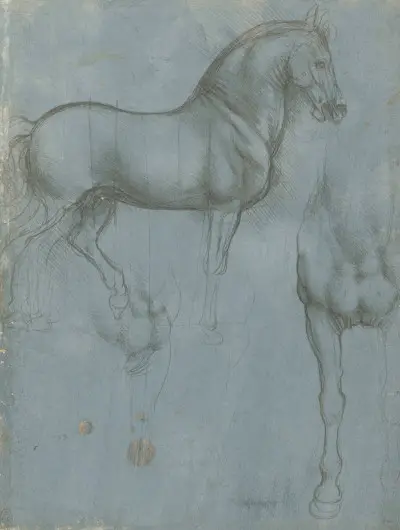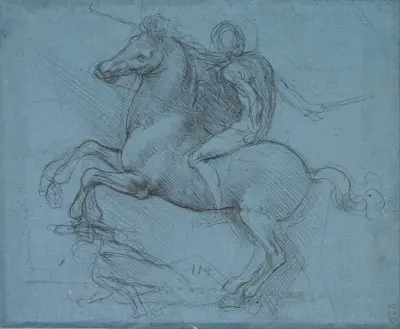 Leonardo da Vinci.jpg) Buy Art Prints Now
Buy Art Prints Nowfrom Amazon
* As an Amazon Associate, and partner with Google Adsense and Ezoic, I earn from qualifying purchases.
Horse and Rider is a sculpture made from beeswax which has been attributed by an art historian to Leonardo da Vinci. Others have disputed this connection, and the debate continues to this day.
Introduction
This item is generally regarded as a maquette, or model sculpture, for a larger, later piece. It is likely that the full scale sculpture would have been completed in bronze, with models such as this often used for the purposes of acquiring a commission in a time efficient manner.
The Horse and Rider has received considerable attention in recent years because of the relatively recent attribution to Leonardo that was given to it by Carlo Pedretti in 1985. With such a small oeuvre in this medium, any sculptures linked to Da Vinci would provide invaluable information on how he worked as a sculptor.
We do know for sure that the artist was interested in horses, and would regularly sketch them. He found their movements to be suitable for his work, and so for him to want to create three dimensional forms of them seems entirely plausible. It must also be remembered that horse sculptures were regularly commissioned in Renaissance Italy because of the symbolic meanings that they could deliver, of power and strength, as well as beauty.
There are also many, many drawings left over from Da Vinci's career which detail horses in all manner of different postures and angles. The artist seemed determined to understand their anatomy in great depth, and also wanted to use the animal to investigate movement within art.
One is left to consider the views of different art historians, one of whom believes this to be an original Leonardo sculpture, whilst others do not. It must be remembered that similar debates rage around some Da Vinci paintings too, and that many of these mysteries will likely never be solved entirely.
We outline the different historians who have commented on this piece, and their respective views. We cannot really judge ourselves, and leave you to judge for yourselves. Sculpture remains an under-researched part of the artist's career, when for many years he was only really regarded as a painter.
This article examines the Horse and Rider beeswax sculpture in detail, crucially detailing what art historians currently stand on its attribution. We also consider Da Vinci's role as a sculptor more generally, and how his talents in different disciplines would influence his work in others. Finally, we describe the qualities of the piece itself, including technical information around its size and the materials used in its production.
Table of Contents
Description
The sculpture features a horse and rider in traditional clothing matching the period of late 15th century Italy. A warrior, dressed full length in armour, looks across to his right hand side, whilst his body is angled in line with the horse on which he sits. The horse itself has its head bowed.
A long strut is connected into the horse, which ensures the sculpture stays in place upon a wooden stand. The item is considered fragile today, and so it carefully stored within a purpose built environment in order to protect it for centuries to come.
Meaning
It is hard to be certain of the meaning behind this design without knowing more about its creator, and also the commission involved. The horse does appear to be shying away, lowering its head, whilst the rider looks bold and confident. Therefore it is likely that the composition aims to portray the rider in a strong manner, which was often how horses and riders would be used within Renaissance art.
Leonardo's Horse Drawings
Leonardo produced sketches of horses in a variety of guises from around the 1480s right up until his death. He covered horses in movement, in battle, as well as in calmer scenarios. Some of these had specific later monuments in mind, whilst others were purely for the purposes of increasing his understanding of the animal's anatomy.
Da Vinci was famed for the lengths that he went in order to understand accurately the human body and he would take a similar approach to animals, with horses receiving the more attention. He would also cover dogs, bears, pigs and more. The artist left behind thousands of pages of notes and sketches in a series of notebooks and loose pages, and eventually these would be documented and studied in their entirety.
As with many of the genres in which he was involved, the artist would capture horses through observation but also imagination. He varied his mediums, depending on whether he was copying from reality or working from the depths of his mind in a more expressive manner. See below for some of his more famous horse drawings from across the full span of his lifetime.

Studies of a Horse, circa 1490, Royal Collection

Study for Leonardo's Horse
Attribution
Italian art historian Carlo Pedretti attributed Horse and Rider to Leonardo da Vinci in 1985. Two years later he would feature photographs of the sculpture within a publication on the artist's drawings and slowly this piece would start to gain prominence within the art world.
Professor Ernesto Solari [from Wikipedia] also connected the piece to Leonardo more recently, whilst others such as Martin Kemp [from Wikipedia] have rejected the attribution. Most art historians have not actually covered the piece within their own publications on the artist's life and career, as previously it was relatively unknown.
Size and Medium
Horse and Rider is a beeswax sculpture which measures 10 inches in height (25 cm) by 9 inches (23 cm) long and 3.5 inches (9 cm) wide. It is therefore one of the smallest artworks to have been attributed, by some, to Leonardo but this is in-keeping with its role as a maquette, where it served as a model for a larger yet-to-be commissioned sculpture.
References
- Leonardo. The Complete Paintings and Drawings, Frank Zöllner & Johannes Nathan, Taschen
- Leonardo da Vinci, Walter Isaacson




